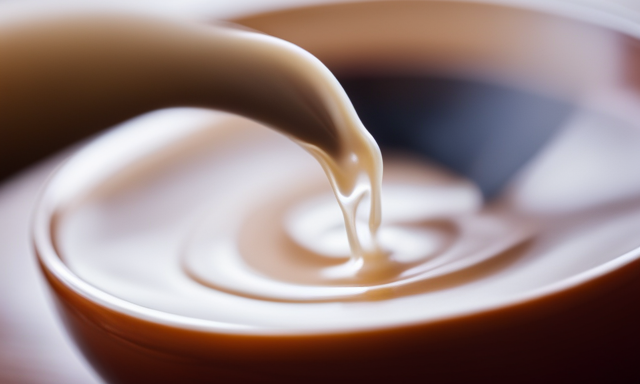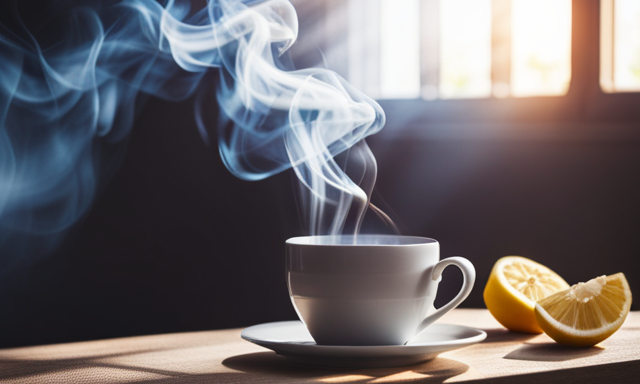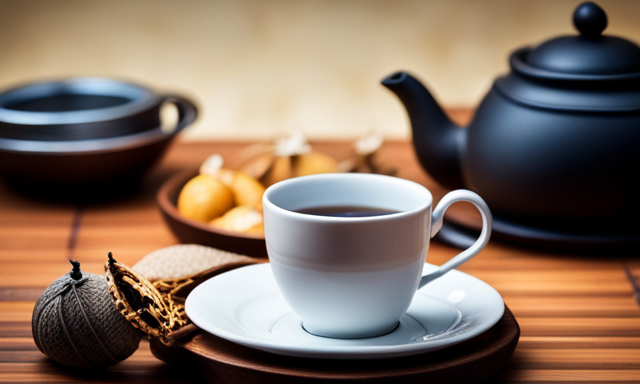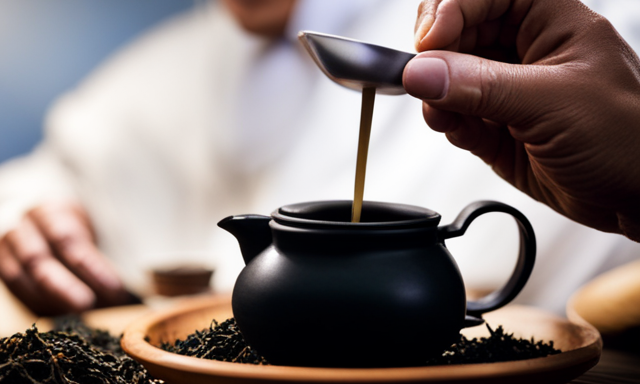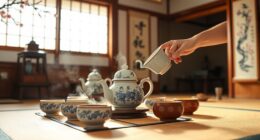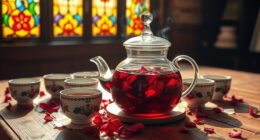Have you been aware of the rise in popularity of oolong milk tea among tea lovers, as they seek the ideal combination of flavorful richness and creamy smoothness?
Well, I certainly did, and I’m here to guide you on the journey to discovering the best tea to use for oolong milk tea. As a tea aficionado myself, I’ve spent countless hours experimenting with different types of oolong tea and exploring the various flavor profiles they offer.
In this article, I will share my knowledge and expertise to help you select the perfect tea leaves for your oolong milk tea. We’ll delve into the importance of understanding roasting levels, tea-to-milk ratios, and even adding flavor variations for a unique twist.
So, grab a cup of your favorite oolong milk tea, sit back, and let’s dive into the world of teas that will elevate your milk tea experience to new heights.
Key Takeaways
- Choose high-quality oolong tea for the best flavor in oolong milk tea
- Experiment with different oolong tea blends to create unique taste profiles
- Use water at around 195°F (90°C) to ensure optimal flavor extraction from the tea
- Use fresh milk to create a creamy and rich texture in oolong milk tea
Exploring Different Types of Oolong Tea
When exploring the various types of oolong tea, it’s important to consider the unique characteristics and flavor profiles each variety offers. Oolong tea is known for its complex flavor notes, ranging from floral and fruity to nutty and toasty.
The flavor of oolong tea can vary depending on the oxidation level and processing techniques used. For example, lightly oxidized oolongs tend to have a more delicate and floral flavor, while heavily oxidized ones have a richer and more robust taste.
Steeping techniques also play a crucial role in bringing out the best flavors in oolong tea. It’s important to follow specific brewing parameters, such as water temperature and steeping time, to achieve the desired flavor profile.
Understanding the flavor profiles of oolong tea is essential in choosing the perfect type for your oolong milk tea recipe.
Understanding the Flavor Profiles of Oolong Tea
To truly appreciate the nuances of oolong milk tea, you should acquaint yourself with the diverse flavor profiles that oolong possesses. Oolong tea is known for its complex taste, which can vary depending on factors such as cultivation and oxidation levels. Exploring oolong tea cultivation will reveal the different growing regions and their unique terroirs, which contribute to the flavor of the tea. For example, teas grown in Taiwan are prized for their floral and fruity notes, while teas from China often have a more earthy and roasted flavor. Additionally, understanding oolong tea oxidation levels is crucial in determining the taste of the tea. Lightly oxidized oolongs tend to have a more delicate and floral flavor, while heavily oxidized oolongs have a richer and more robust taste. By delving into these aspects, you can better select the best tea leaves for oolong milk tea, ensuring a harmonious blend of flavors.
Selecting the Best Tea Leaves for Oolong Milk Tea
When selecting the best tea leaves for oolong milk tea, it is essential to consider the unique milk alternatives available and understand the health benefits of oolong tea.
Exploring different milk options such as almond, coconut, or oat milk can add a delightful twist to your beverage, enhancing its creaminess and flavor. Additionally, oolong tea offers numerous health benefits, including boosting metabolism, aiding digestion, and promoting heart health.
By using high-quality tea leaves, you can fully experience the rich, complex flavors that oolong tea has to offer.
Now, let’s delve into considering the roasting level of oolong tea, which plays a crucial role in determining its taste and aroma.
Considering the Roasting Level of Oolong Tea
The roasting level of oolong leaves significantly impacts their taste and aroma. Lighter roasts emphasize floral and fruity notes, while darker roasts bring out richer and nuttier flavors that will leave your taste buds craving for more. When selecting tea leaves for oolong milk tea, it’s important to consider the roasting level to achieve the desired flavor profiles. Here are some key points to keep in mind:
- Lighter roasts: Enhance the natural floral and fruity notes of oolong tea, resulting in a delicate and refreshing taste.
- Darker roasts: Bring out deeper, nuttier flavors, creating a robust and satisfying cup of oolong milk tea.
- Medium roasts: Strike a balance between floral and nutty flavors, offering a harmonious blend of taste profiles.
- Roasting intensity: Determines the strength of the roasted aroma, with lighter roasts having a milder scent and darker roasts exuding a more pronounced roasted fragrance.
- Personal preference: Experiment with different roasting levels to find your perfect oolong milk tea flavor.
Now, let’s delve into the next section and explore the art of experimenting with different tea-to-milk ratios.
Experimenting with Different Tea-to-Milk Ratios
Discover the art of achieving a refined and sophisticated flavor profile by experimenting with various ratios of tea and milk in your oolong milk tea. The ratio of tea to milk can greatly impact the overall taste and texture of your beverage. To help you navigate the world of tea-to-milk ratios, consider the following table:
| Tea-to-Milk Ratio | Flavor Profile | Texture |
|---|---|---|
| 1:1 | Balanced | Creamy |
| 1:2 | Strong tea | Light |
| 1:3 | Subtle tea | Thin |
By adjusting the ratio, you can find the perfect balance that suits your preferences. Whether you prefer a stronger tea flavor or a creamier texture, experimenting with different ratios allows you to tailor your oolong milk tea to your liking. Now that you have mastered the tea-to-milk ratios, let’s explore how to enhance the creaminess with sweeteners or condensed milk.
Enhancing the Creaminess with Sweeteners or Condensed Milk
To enhance the creaminess of your oolong milk tea, you can try adding sweeteners or condensed milk. It’s interesting to note that 76% of tea enthusiasts prefer using these additions to elevate the richness of their beverage. Here are three options to sweeten your oolong milk tea and enhance its creaminess:
-
Honey: Add a spoonful of honey for a natural sweetness that complements the earthy notes of oolong tea.
-
Brown sugar: Sprinkle some brown sugar into your milk tea to add a caramel-like flavor that enhances the creaminess.
-
Condensed milk: For a decadent treat, stir in a dollop of condensed milk to create a velvety and luscious texture.
If you prefer alternative milk options, consider using coconut milk or almond milk instead of regular milk. These options can add a subtle nuttiness that pairs well with oolong tea.
Now that we’ve enhanced the creaminess, let’s explore adding flavor variations to oolong milk tea.
Adding Flavor Variations to Oolong Milk Tea
Try experimenting with different flavor variations to elevate your oolong milk tea experience. One way to enhance the flavor is by using flavored milk alternatives, such as almond or coconut milk. These alternatives add a subtle sweetness and a unique twist to your tea.
Another option is to add fruit extracts, like strawberry or mango, to infuse your oolong milk tea with a burst of fruity goodness. These extracts not only provide a delightful taste but also a refreshing aroma.
By incorporating these flavor variations, you can create a personalized oolong milk tea that suits your taste preferences.
Now, let’s explore tea blends for a unique twist in our oolong milk tea journey.
Exploring Tea Blends for a Unique Twist
Exploring different tea blends can add a unique twist to your oolong milk tea experience. Over 20% of tea drinkers opt for flavored blends, and tea blending techniques offer endless possibilities for creating interesting flavor profiles.
By combining oolong tea with other varieties like jasmine or Earl Grey, you can enhance the taste and aroma of your milk tea.
Additionally, experimenting with alternative milk options, such as almond or coconut milk, can provide a delightful twist to your traditional oolong milk tea. These alternative milks can bring a hint of nuttiness or a tropical touch to your beverage.
As you delve into the world of tea blending and alternative milks, you’ll discover new dimensions of flavor that will elevate your oolong milk tea experience.
Now, let’s explore trying different brewing methods for oolong milk tea.
Trying Different Brewing Methods for Oolong Milk Tea
Get ready to elevate your oolong milk tea experience by experimenting with different brewing methods. You’ll be amazed at the unique flavors and aromas you can unlock! Here are some sophisticated brewing techniques that can take your oolong milk tea to the next level:
-
Adjust the brewing time: Depending on the oolong tea you’re using, the ideal brewing time can vary. Experiment with shorter or longer steeping times to find the perfect balance of flavors.
-
Control the tea temperature: Oolong tea is delicate, so it’s crucial to get the water temperature right. Aim for around 195°F (90°C) to ensure that you extract the best flavors without scorching the leaves.
By carefully adjusting these factors, you can create a personalized oolong milk tea that suits your taste preferences.
Now, let’s move on to some tips for enjoying the perfect cup of oolong milk tea.
Tips for Enjoying the Perfect Cup of Oolong Milk Tea
After experimenting with different brewing methods for oolong milk tea, I have discovered some useful tips for enjoying the perfect cup.
Firstly, to achieve that delightful frothiness, it’s important to use fresh milk and froth it up properly before adding it to the tea. This creates a creamy texture that enhances the overall taste and experience.
Secondly, selecting high-quality oolong tea is crucial as it directly impacts the flavor of the milk tea. Look for oolong tea that has been properly processed and has a balanced taste profile.
Lastly, it’s worth mentioning the numerous health benefits of oolong tea. This type of tea is known for its ability to boost metabolism, aid in weight loss, and improve heart health. So not only can you enjoy a delicious cup of oolong milk tea, but you can also reap the benefits for your overall health and wellness.
Frequently Asked Questions
What are the health benefits of oolong milk tea?
Oolong milk tea offers a delightful taste experience, with its unique blend of oolong tea and creamy milk. Compared to black milk tea, it has a more nuanced flavor profile. Additionally, oolong milk tea holds a rich history and cultural significance, making it a cherished beverage.
Can I use any type of milk for oolong milk tea?
You can use different types of milk for oolong milk tea, each offering its own benefits. From creamy dairy milk to plant-based alternatives like almond or oat milk, the choice is yours to create a unique and enjoyable beverage.
How long should I steep oolong tea before adding milk?
To properly steep oolong tea, I suggest steeping it for 3-5 minutes in water that is around 190-200°F. Once steeped, add your desired milk. The best milk options for oolong milk tea are usually whole milk or oat milk.
Can I use flavored oolong tea for making oolong milk tea?
Yes, you can use flavored oolong tea to make oolong milk tea. There are many alternatives to traditional oolong tea, such as jasmine oolong or peach oolong, that can add a unique flavor to your milk tea.
Are there any specific tea accessories recommended for making oolong milk tea?
For the perfect oolong milk tea, I recommend using a tea infuser to steep the loose leaves. Additionally, a milk frother is essential for achieving a creamy texture. These accessories can greatly enhance your tea-making experience.
Conclusion
In conclusion, finding the perfect tea for oolong milk tea is a journey of exploration and experimentation. By understanding the different types of oolong tea and their flavor profiles, selecting the best tea leaves, considering the roasting level, and playing with tea-to-milk ratios, you can create a truly exquisite cup.
Adding flavor variations and exploring tea blends can also add a unique twist to your oolong milk tea experience. Don’t be afraid to try different brewing methods to find your perfect cup.
So, grab your teapot and embark on a flavorful adventure that will leave you craving more.

